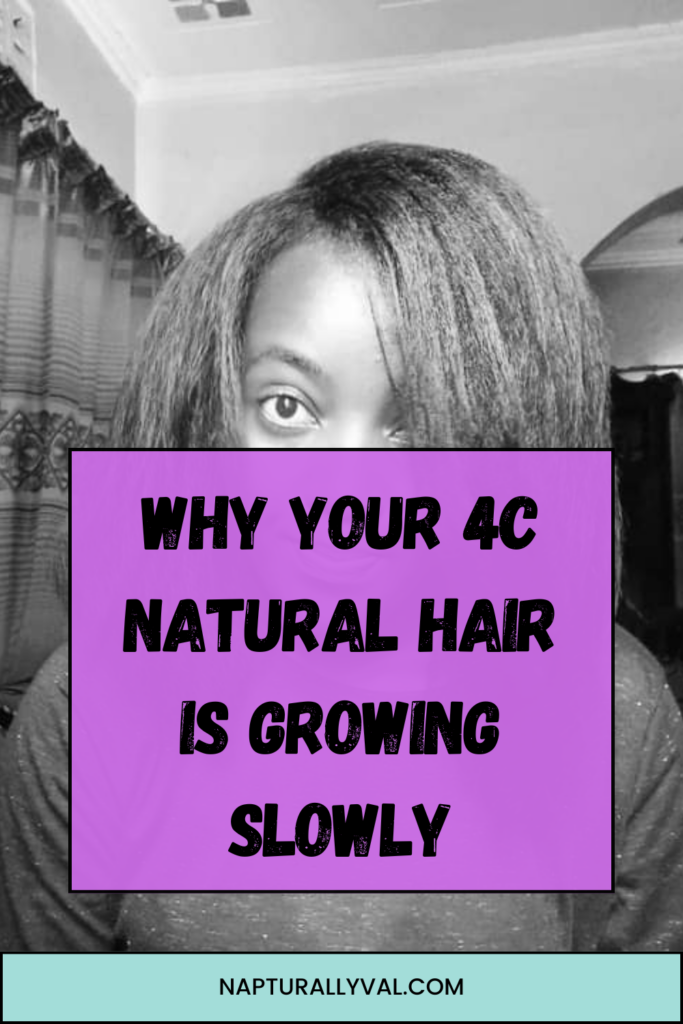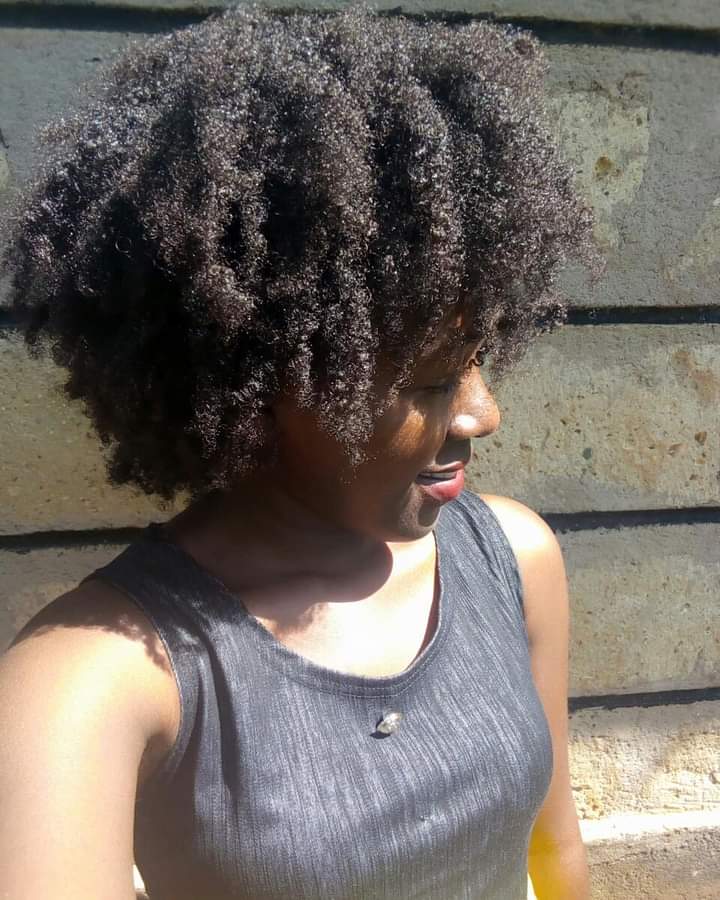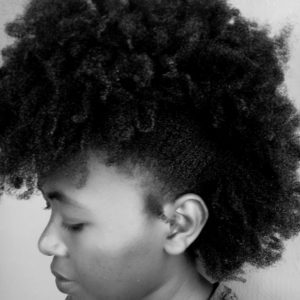Growing 4C natural hair can sometimes feel like a slow journey, and if you’re frustrated with the length (or lack thereof) you’re seeing, you’re not alone. I know the struggles firsthand—4C hair often gets the reputation for growing slower than other hair types. But guess what? It’s not that your hair isn’t growing at all. It’s just that 4C hair tends to shrink and tangle more, making length retention a real challenge. In this blog post, we’ll break down the most common reasons why your 4C hair may seem like it’s growing slowly, and how you can turn that around to get the healthy length you desire.
Feel like your hair has been the same length forever, I’ve an Ebook that will help you grow your hair healthier, longer and thicker. Grab your copy here… Also, check out all the Ebooks,guides and journals that will go a long way in your hair care journey here.

Table of Contents
Understanding 4C Hair Growth
First things first: it’s important to know that everyone’s hair grows at an average rate of about half an inch per month. This applies to all hair types, including 4C hair. However, what makes 4C hair unique is its tight curl pattern, which can shrink up to 75% of its actual length. This shrinkage makes it look like your hair isn’t growing as fast as other hair types, when in reality, the growth is just less visible.
But shrinkage isn’t the only factor at play here. Let’s dive into some other reasons why your 4C hair might be growing slowly or why you might not be retaining length.
Stunted Growth? 5 Hidden Culprits Slowing Down Your 4C Hair
1. Breakage
One of the most common reasons your 4C hair may not be growing as fast as you’d like is due to breakage. 4C hair, with its beautiful, coily structure, is naturally more prone to dryness. Why? The sebum (natural oils) that your scalp produces has a harder time traveling down the coils of your hair, leaving the ends dry and brittle. If your ends are breaking off at the same rate your hair is growing, you won’t see the length you’re hoping for.
How to Address It:
Moisture is your best friend! Incorporate deep conditioning treatments into your weekly routine and use a leave-in conditioner after every wash to add & seal in moisture. Make sure you’re using hydrating products that cater specifically to 4C hair, like those containing aloe vera, glycerin, and oils such as jojoba or castor oil. Protective styling is also crucial to minimizing breakage, but be careful not to overdo it—too-tight braids or twists can lead to more breakage.

2. Not Trimming Your Ends
I know this can be a tough one because trimming your hair when you’re trying to grow it out seems counterintuitive. However, not trimming your ends can lead to more split ends, which eventually work their way up the hair shaft, causing breakage and thinning over time. Damaged ends make it impossible to retain length, no matter how fast your hair is growing.
How to Address It:
Trim your ends every 4 to 6 months, or as needed. You don’t need to cut off a lot—just enough to get rid of any damaged or split ends. Healthy ends are essential for length retention.
3. Over-Manipulation
4C hair is delicate, and the more you manipulate it, the more prone it is to breakage. Constantly combing, brushing, or restyling your hair can cause stress on your strands, leading to breakage over time. Even detangling sessions, if done improperly, can cause more harm than good.
How to Address It:
Adopt a low-manipulation routine. Opt for protective styles that require minimal daily handling, like mini twists, braids, or buns. When you do need to detangle, use your fingers or a wide-tooth comb and work through your hair in sections. Always detangle your hair when it’s damp and use a good detangling product to make the process smoother.
4. Tight Hairstyles
As tempting as it is to pull your hair into sleek buns or tight braids, these styles can cause stress on your scalp and hair follicles, which can lead to breakage around your hairline and scalp tenderness. If you wear tight styles frequently, you could also develop traction alopecia, which is a form of hair loss caused by constant tension on the hair follicles.
How to Address It:
Loosen up! Opt for looser hairstyles that put less strain on your scalp. You can still rock a protective style, but make sure your edges aren’t being tugged. Your hairline will thank you.

5. Poor Diet
Your hair’s health is often a reflection of your overall health. If you’re not getting the right nutrients, your hair may grow slower or be more prone to breakage. Diets lacking in essential vitamins like iron, zinc, and vitamins A, C, D, and E can negatively impact hair growth.
How to Address It:
Make sure you’re eating a well-balanced diet rich in fruits, vegetables, lean proteins, and healthy fats. If necessary, consider taking a multivitamin or a hair growth supplement that includes biotin, iron, and other essential nutrients to support hair growth from the inside out.
6. Lack of Scalp Care
Healthy hair starts with a healthy scalp. If your scalp isn’t getting the care it needs, hair growth can slow down. Build-up from products, dirt, or oils can clog your hair follicles, making it difficult for new hair to grow through. On the other hand, a dry, flaky scalp can also inhibit growth by creating an unhealthy environment for your hair to thrive.
How to Address It:
Give your scalp some love! Incorporate a gentle scalp massage into your routine to stimulate blood circulation, which promotes hair growth. Use a sulfate-free clarifying shampoo to cleanse your scalp and remove build-up, but don’t overdo it—4C hair thrives with moisture, so you don’t want to strip your hair of its natural oils.
7. Heat Damage
Using heat styling tools like flat irons or blow dryers can cause significant damage to your 4C hair if not used properly. Excessive heat can weaken the hair shaft, making it prone to breakage and split ends. Heat damage can also alter your curl pattern, leading to a loss of definition and elasticity.
How to Address It:
If you must use heat, always apply a heat protectant first to create a barrier between your hair and the heat. It’s best to avoid using heat altogether, but if you do, try to limit it to special occasions. Air drying and embracing your natural curl pattern is always a safer bet for maintaining the health of your 4C hair.

8. Not Drinking Enough Water
Just like your skin, your hair needs hydration from the inside out. If you’re not drinking enough water, your hair may become dry and brittle, making it more prone to breakage.
How to Address It:
Make sure you’re drinking at least 8 glasses of water a day. Staying hydrated will help keep your hair moisturized and strong, contributing to better length retention.
Final Thoughts: Patience Is Key!
Remember, growing long, healthy 4C hair takes time and patience. You might not see dramatic results overnight, but by taking the right steps, you can make significant progress. Focus on retaining the length you have, keeping your hair moisturized, avoiding excessive manipulation, and treating your scalp and body well. Your hair is growing—sometimes it just takes a little extra care to see the results you’re hoping for!
Let me know in the comments how your hair journey is going and if you’ve experienced any of these challenges. Let’s keep the conversation going and support each other on this 4C hair growth journey!



